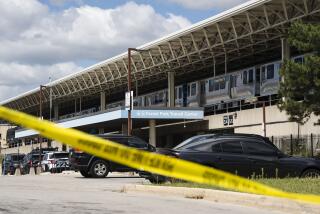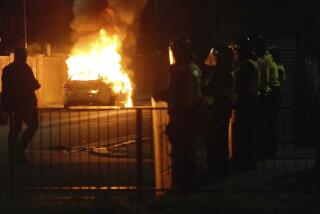London Police Kill Suspect in Subway
- Share via
LONDON — Plainclothes police engaged in the frenetic hunt for fugitives involved in London’s transit bombings pursued a suspect into an Underground train Friday and shot him to death in front of screaming and cowering passengers.
It was not clear whether the man, described as a young Asian wearing a heavy coat despite the summer heat, was one of four men who had tried to set off backpack bombs on three subway trains and a bus Thursday, attempts that mirrored a spate of bombings July 7 that killed 56 people, including four bombers. Police did not immediately identify the man or say whether he was carrying weapons or explosives.
Officials said that plainclothes police had followed the man after he left a house that had been under surveillance and that they tried to stop him as he approached a train station.
Police also made public images of the four suspects in the Thursday attacks, who had been filmed by security cameras. They asked the public to help identify and find the men.
A series of raids around the capital disrupted traffic and riveted the attention of Londoners. Police officers searched three houses in what Ian Blair, chief of the Metropolitan Police, called a “very, very fast-moving investigation.”
One man was arrested at a home near the Underground shooting, and Scotland Yard said he was being held under a section of anti-terrorism law aimed at significant suspects. Another man was arrested at a train station in Birmingham, but was not expected to face charges.
Forensic examination indicated that the unexploded bombs recovered Thursday contained a homemade brew of explosives similar to those used in the July 7 bombs, officials said. The finding reinforces the theory that the same terrorist group attempted a follow-up attack Thursday but failed, two senior European police officials said. At least one bomb apparently contained nails to increase the deadliness of the blast, however, unlike the devices used two weeks ago.
The gunfire on London’s Underground, commonly known as the Tube, erupted about 10 a.m. at the Stockwell Station in Brixton, a working-class area of South London with a large population of Caribbean and African descent. The station is on the Northern Line near the Oval Station, one of the targets of the bombing attempts Thursday.
Police said in a statement that officers had followed the man to the Stockwell Station from a house that was under surveillance as part of the investigation of the bombing attempts.
“His clothing and behavior at the station added to their suspicions,” the statement said.
A chase began in the street as the undercover officers converged and pursued the man into the station, witnesses told the BBC, apparently surprising the uniformed officers guarding the station entrance.
“There were at least 20 of them and they were carrying big black guns,” said Chris Wells, 28, a witness interviewed by the Guardian newspaper. “The next thing I saw was this guy jump over the barriers and the police officers were chasing after him.”
Mark Whitby, a commuter, told BBC television that he was reading a newspaper when the fugitive burst into his subway car with police on his heels. Witnesses described the man as a stocky young Asian with a shaved head and short beard, wearing a baseball cap and a padded winter coat. In Britain, the term “Asian” usually refers to people whose roots lie in South Asian nations such as Pakistan, India and Bangladesh.
Watching from the platform, journalist Chris Martin said police grappled with their quarry before the shots were fired.
“They came flying onto the platform and these guys just threw this man into the open doors of the train,” Martin said, according to the Guardian website. “Then I heard the shots.... It sounded like a silencer gun going off, and then there was blind panic, with people shouting and screaming and just running away.”
Whitby said a single officer had opened fire at close range.
“I heard a load of noise ... people saying, ‘Get out, get out,’ ” Whitby said. “I saw an Asian guy. He ran onto the train, he was hotly pursued by three plainclothes officers ... he half-tripped and was half-pushed to the floor and the policeman nearest to me had the black automatic pistol in his left hand. He held it down to the guy and unloaded five shots into him.”
Whitby said the suspect did not appear to be carrying anything, but looked as if he “might have had something concealed underneath” his coat, “which looked sort of out of place with the weather we have been having, the sort of hot, humid weather.”
In the moments before he was shot, the suspect “looked like a cornered fox,” Whitby said. “He looked petrified.”
Police expressed regret about the death, which was being investigated by an internal affairs division. But Blair said the suspect had resisted officers and left them no choice.
“I need to make clear that any death is deeply regrettable,” the police chief said. “But as I understand the situation, the man was challenged and refused to obey police instructions.”
A senior European police official said British counterparts had indicated that questions remained about the man’s degree of involvement in any terrorist plot.
“The British have told us they are not yet sure about him,” the European official said. “It is very unusual for the British to shoot someone, but they may have thought he was about to set off a bomb.”
Shootings by police are rare in Britain, but police here are on maximum alert because they think terrorists are at large and ready to strike again.
Andy Hayman, assistant police chief for special operations, said officers backed by dogs and bomb squads had carried out three raids, including one on a house in West London where they tossed a tear gas canister through the front door.
A news conference Friday became the stage for the dramatic unmasking of the four suspects in Thursday’s attempted bombings, thanks to London’s omnipresent network of closed-circuit television cameras.
The most distinct and powerful image came from the Oval Station, south of the River Thames near Stockwell: It shows a solidly built young man with a shaved head, wearing a dark sweatshirt with “New York” on the chest, running through what appears to be a station corridor. The sweatshirt was later recovered in the Brixton neighborhood, Hayman said.
Another image, taken aboard a double-decker bus, is a close-up of an apparently middle-aged man with a mustache. He is wearing a white baseball cap and gray T-shirt with a palm tree logo. He allegedly carried a bomb in a backpack bearing the logo of Fitness First, a chain of health clubs, and attempted to detonate it when the bus was in the Hackney neighborhood, authorities said.
The pictures of the suspects vary in quality. The men at Oval and Hackney appear to be of African or Middle Eastern descent, as does a suspect from the Warren Street Station. A cap obscures the face of the fourth suspect, a bearded youth wanted for allegedly attempting a bombing at the Shepherd’s Bush Station.
In the July 7 attacks, three of the dead bombers were Britons from Pakistani immigrant families who lived in or around the northern city of Leeds, police say. The fourth was a Jamaican-born British convert to Islam who lived north of London. Investigators think the bombers belonged to a network overseen by Al Qaeda operatives based in Pakistan with contacts in Britain and North America.
Hayman provided more details Friday about the bombing attempts Thursday, which did not harm anyone because the bombs did not fully detonate.
“Initial forensic examination indicates that a bomb partially detonated at each of the four sites,” Hayman said. “At this stage it is believed that the devices consisted of homemade explosives and were contained in dark-colored bags or rucksacks.”
Investigators do not yet know how the bombs were detonated, Hayman said. He called the explosives homemade, a description consistent with statements by U.S. and European investigators that they contained triacetone peroxide, or TATP, the volatile mixture used in the July 7 bombs.
Some experts have speculated that the maker of the bombs used Thursday made an error in building them, or that the materials degraded over time. If the proportions of chemicals are not properly balanced, such bombs can simply burn rather than explode, they say.
Abisha Moyo, an immigrant from Zimbabwe, said he spoke to the Shepherd’s Bush bomber in the moments after the explosion Thursday. After hearing a loud bang in the subway car, Moyo saw a young man lying prone with smoke coming out of the backpack he wore.
“I wasn’t sure what had happened to him and thought he might have been shot,” Moyo, 28, told the Daily Mail newspaper. “I went up to him and said, ‘Are you all right, mate?’ But he just ignored me and kept his eyes shut. ... He looked very dazed and confused and very shaken.”
Moyo said he realized he was face to face with a bomber when he spotted wires protruding from the T-shirt of the man, whom he described as about 19 and of mixed race, wearing a cap, blue T-shirt and jeans, according to the newspaper. The man fled through an emergency exit and jumped down onto the tracks, Moyo said.
British and European police lean toward the theory that the July 7 attacks were the first suicide bombings in Western Europe, but have stopped short of declaring that grim milestone because of troubling ambiguities, especially the fact that the attackers apparently did not leave behind video statements or wills.
“In their communications with us, the British still talk about it in the conditional: the presumed suicide bombings,” a top European law enforcement official said. “There are still a lot of strange things about the July 7 attacks. And there are strange things about Thursday too.”
Times staff writers John Daniszewski and Janet Stobart contributed to this report.
More to Read
Sign up for Essential California
The most important California stories and recommendations in your inbox every morning.
You may occasionally receive promotional content from the Los Angeles Times.













